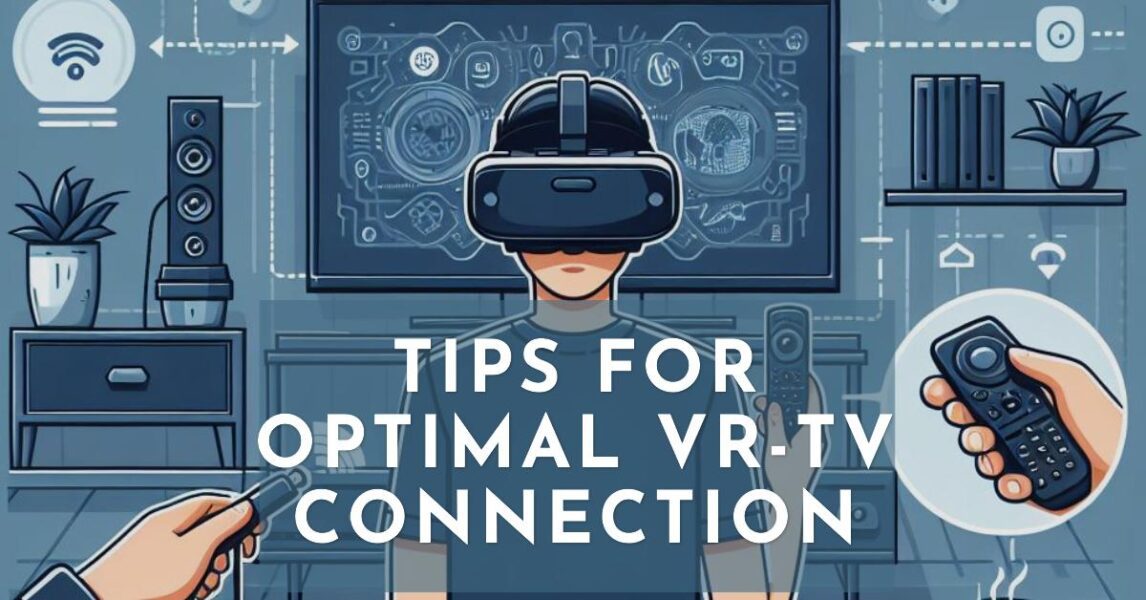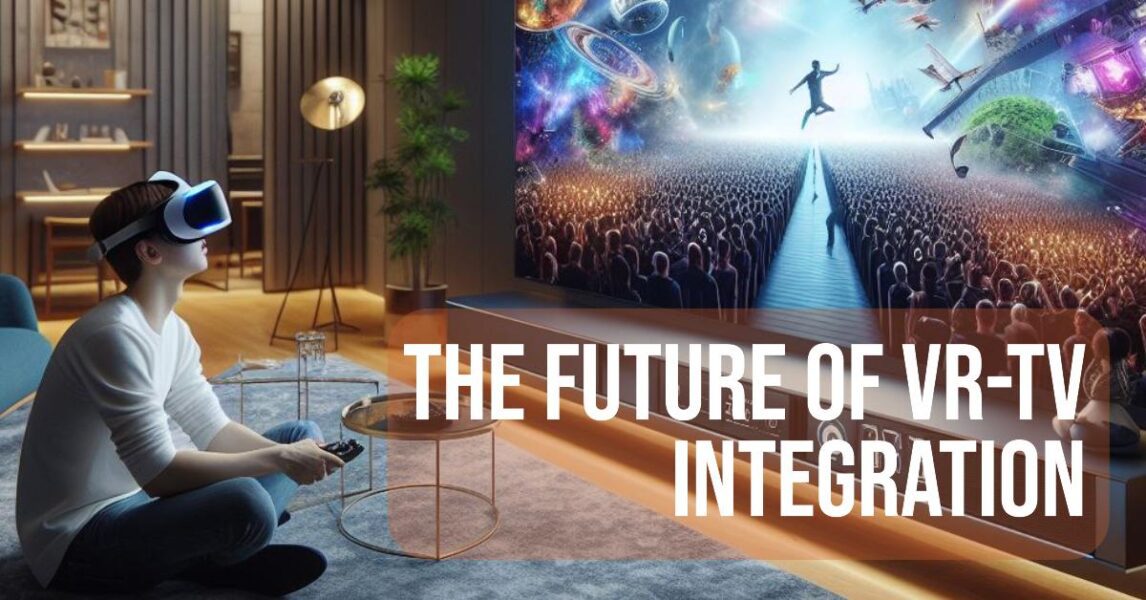The way we interact with digital information has been completely transformed by virtual reality (VR) technology, which transports users to virtual worlds like never before. As virtual reality devices gain popularity, a lot of fans are keen to learn new techniques for improving their VR encounters. One such method is How to Connect Virtual Reality to TV to link virtual reality headsets to TVs, which enables more cooperative & immersive watching. In this TechyNerd post, we’ll get into the specifics of virtual reality TV connectivity, offering readers a thorough how-to.

Why Connecting VR to TV Matters?
before answering this question of How to Connect Virtual Reality to TV, we have to first understand why it matters.
Collective Engagement
VR is typically an individual experience, with the user engrossed in a virtual world. By linking the VR headset to a TV, others in the room can witness what the VR user is experiencing, transforming a personal experience into a communal one. This can be particularly enjoyable in a social setting, allowing friends to participate in the action.
Expanded Display
Linking a VR headset to a TV allows users to enjoy VR games and watch VR movies on a bigger screen. This can provide a more immersive experience, especially for spectators.
Instructional & Demonstrative Uses
In an instructional or demonstrative setting, casting a VR experience on a TV can be beneficial. It allows a group of students or an audience to see exactly what the VR user is seeing & doing.
Improved Gameplay
For games where spectators can participate or provide directions to the player in the VR, having the game displayed on the TV can enhance gameplay.
Cinematic Experiences
Beyond gaming, the film & television industries have also started to embrace the potential of VR. By creating immersive cinematic experiences, filmmakers can transport viewers into the heart of the story, fostering a deeper connection with the narrative & characters.
Also Read: Top 6 Best AR Glasses for Navigation in 2024
How to Connect Virtual Reality to TV?
Connecting your VR headset to your TV can enhance your virtual reality experience. The process may vary depending on the brand & model of your VR headset & TV, but the basic steps remain the same. Here’s a comprehensive TechyNerd guide on how to connect virtual reality to TV:
Step 1
Check compatibility. Before you start connecting your VR headset to your TV, it’s crucial to ensure compatibility between the two devices. Here’s how you can check if your VR headset & TV are compatible:
1. Check the HDMI ports: Most VR headsets, such as the Oculus Rift, HTC Vive, & PlayStation VR, require an HDMI connection to the TV.
2. Verify the HDMI version: Some VR headsets, like the Oculus Rift S, require an HDMI 2.0 port for optimal performance.
3. Confirm the resolution: VR headsets often have specific resolution requirements for the TV.
4. Consider audio compatibility: Some VR headsets have built-in headphones or require separate audio connections.
Step 2
Connect using HDMI or USB cable. You can connect your VR headset to your TV using an HDMI or USB cable. Here are the steps:
1. Connect one end of the HDMI or USB cable to the VR headset.
2. Connect the other end of the HDMI or USB cable to the HDMI or USB port on your TV.
3. Turn on your TV and select the appropriate input.
4. Turn on your VR headset.
Step 3
Connect using wireless casting. If your TV has Chromecast capabilities, you can cast your VR gameplay to your TV. Here’s how:
1. Ensure that your phone, VR headset, & TV (or Chromecast device) are on the same wifi network.
2. Launch your VR headset & your TV.
3. Run the VR app on your smartphone.
4. Look for the Cast icon on the top right-hand side of the app window.
5. Select your VR headset from the drop-down list.
6. Go to the “Cast to” section, and select your TV or your Chromecast device.
7. Click “Start” at the bottom of the screen to begin casting your VR headset’s gameplay on your TV screen.
Also Read: Step into Tomorrow: How to Access the Metaverse Like a Pro
Tips for Optimal VR-TV Connection

Compatibility Check
Before you start, make sure your VR headset & TV are compatible. Check the HDMI ports, verify the HDMI version, confirm the resolution, & consider audio compatibility.
Correct Cables
Use the appropriate cables to connect the HDMI & USB ports of the VR headset to the TV.
Display Mirroring
Enable the correct settings to mirror the VR headset display to the TV.
TV Settings Adjustment
Optimize TV settings like resolution & refresh rate for the best VR visuals. For instance, select a picture mode that provides a bright & vibrant display, set the resolution of your TV to match the recommended resolution of your VR headset, and VR experiences often benefit from a higher refresh rate.
Input Lag Reduction
Minimize input lag as much as possible for a smoother VR experience.
Audio Output Setup
Set the audio output to either the TV speakers or your preferred audio system.
TV & VR Play Area Positioning
Arrange your TV & VR play area to allow for safe movement when wearing the headset.
Wireless Casting
If your TV has Chromecast capabilities, you can cast your VR gameplay to your TV. Ensure that your phone, VR headset, & TV (or Chromecast device) are on the same wifi network.
Also Read: Beyond the Stage: Exploring the Metaverse for Musicians
Future of VR-TV Integration

Accessibility is Key
As we move forward, developers are focusing on making VR more accessible to a wider range of users. We can expect to see lighter, more comfortable headsets & more accessible software for people with disabilities.
Interplay with Other Technologies
VR is increasingly being integrated with other technologies such as artificial intelligence (AI) & machine learning. These technologies can enhance the accuracy & realism of VR experiences, making them more immersive & engaging for users.
Hardware Evolution
VR hardware is evolving rapidly, with new devices & accessories constantly being developed. As the technology continues to advance, we can expect further improvements in display quality, comfort, & affordability.
Wireless Casting
The advent of 5G technology will enable more devices & users to be connected, providing real-time & seamless experiences. This will enhance the ability to cast VR gameplay on TVs.
Immersive Cinematic Experiences
Beyond gaming, the film & television industries have also started to embrace the potential of VR. By creating immersive cinematic experiences, filmmakers can transport viewers into the heart of the story, fostering a deeper connection with the narrative & characters.
Shared Viewing Experience
Connecting a VR headset to a TV allows others to see what the VR user is seeing, turning a solitary experience into a shared one. This can be particularly enjoyable in a group setting, allowing friends to join in on the action.
Also Read: How to Invest in the Metaverse: 6 Powerful Ways to Financial Growth
Wrapping Up
Mastering how to connect virtual reality to TV unlocks a world of immersive experiences. Whether for gaming, instructional purposes, or cinematic enjoyment, linking your VR headset to a TV enhances engagement & collective enjoyment. By ensuring compatibility, using the right cables, & optimizing settings, you can seamlessly integrate VR with your television. As technology evolves, wireless casting & future advancements promise even more seamless integration. Embrace the shared viewing experience & expand the possibilities of your virtual reality encounters by bridging the gap between VR & TV.
FAQ’s
Can I connect any VR headset to any TV?
You can connect a VR headset to a TV, but compatibility varies. Check your device’s requirements, connect via HDMI, & ensure both are on the same Wi-Fi network. Always refer to specific device manuals for detailed instructions.
What if my TV doesn’t have HDMI or USB ports?
If your TV lacks HDMI or USB ports, consider using a VGA port if available, or adapters/hubs for connections. Some VR headsets allow wireless casting to a TV via devices like Google Chromecast. Always check device manuals for specific instructions & compatibility details.
Are there any latency issues when streaming VR content to TV wirelessly?
Yes, streaming VR content to a TV wirelessly can introduce latency, or delay, due to Wi-Fi connection quality and the process of compressing & decompressing video frames. Newer Wi-Fi standards like Wi-Fi 6 can help reduce latency.
Can I use VR-specific apps to stream content to TV?
Yes, VR-specific apps like YouTube VR, Netflix, Amazon Prime Video, Vimeo, & VRidge allow you to stream VR content to a TV. These apps offer a range of VR videos, movies, & games, providing an immersive viewing experience on a larger screen.
What’s the best way to optimize image quality when casting VR content?
To optimize VR image quality, use Super Resolution, a VR-optimized algorithm that enhances clarity. NVIDIA’s Variable Rate Supersampling (VRSS) improves image quality by performing selective supersampling. Anti-aliasing techniques reduce pixelation, enhancing VR graphics without affecting performance. Lastly, experiment with graphics settings like anti-aliasing, render scale, & effects. The optimal settings depend on your specific hardware & software configurations.

